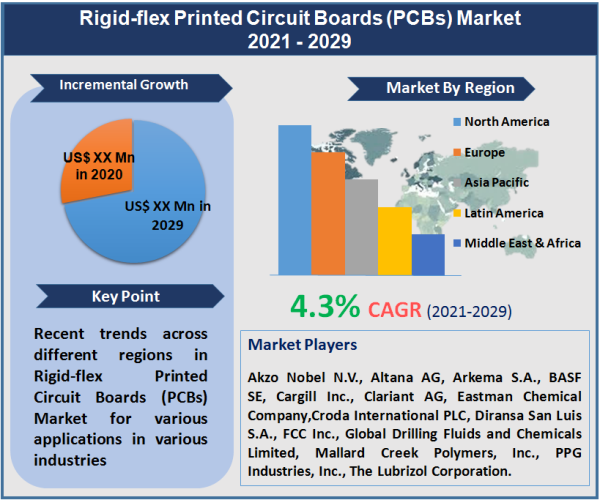Industry Outlook
Rheology modifiers plays an important role many of the end-use industries such as paints & coatings, adhesives & sealants, pharmaceuticals, personal care & cosmetics, construction, agriculture, ceramics, oil & gas, rubber & plastics, textiles, pulp & paper, electronic, food & beverage and textile to name a few. Commonly known as viscosifiers or thickeners, these additives have more influence on a system then simply alter viscosity or thickness of the compound. Now a days plenty of rheological modifiers are present in the market; a detailed understanding of rheological requirement of application is essential for product development. In 2020 market for rheology modifiers stood at US$ 5,039.26 Mn and expected to reach US$ 8237.99 Mn by 2029, expanding at a CAGR of 4.3% from 2021 to 2029. Paints & coating industry is prominently driving the demand for rheology modifiers. This is mainly due to increasing paints & coating application residential and non-residential construction sector along with booming industrial paints & coating application in developing countries such as China, India, Brazil, Indonesia, etc.

"Organic rheology modifiers will maintain its pole position in upcoming years"
In 2020, organic rheology modifiers was the largest segment in terms of value and volume with the market share of more than 65%, of the overall rheology modifiers market worldwide. However, in the coming years, inorganic rheology modifiers expected to emerge as the fastest growing segment in the overall rheology modifiers market by product type. This is mainly due to higher demand for inorganic rheology modifiers from end-use industries such as paints & coatings and adhesives & sealants in developed economies such as the U.S., U.K, Germany, France and other western European countries. For the purpose of the study organic rheology modifiers segment is further sub divided into associative modifiers and non-associative modifiers. Inorganic rheology modifiers segment is further divided into Organoclays (hectorite, bentonite, attapulgite, talcs), Minerals (fumed silica, precipated silica, precipated calcium carbonate, montmorillonite, etc.) and Metal Organic Gellants (zirconates, aluminates, etc.).
"Increasing use Rheology Modifiers in paints & coating end-use industry is driving the demand of Rheology Modifiers in developed as well as developing countries"
Paints & coating segment dominated the global rheology modifiers market in 2020 with a market share of more than 30% and expected to maintain its dominance over the forecast period. Booming construction industry in developing countries as well as growing personal care & cosmetics industry owing to increasing disposable income and purchasing power of customers across the globe is further propelling the demand for rheology modifiers in construction and personal care & cosmetics industry.
"Asia Pacific will be most lucrative market for rheology modifiers from 2021 to 2029"
Increasing industrialization and booming construction industry in the Asia Pacific region expected to drive the demand for rheology modifiers in upcoming years. Region expected to register highest CAGR of 4.9% from 2021 to 2029 as compared to other regions. Europe is another lucrative market for rheology modifiers followed to Asia Pacific owing to increasing demand from paints & coatings and adhesives & sealants end-use industries more prominently in western European countries. North America is likely to witness moderate growth for rheology modifiers in upcoming years. The paints & coating and personal care & cosmetics industry primarily drive regional demand for rheology modifiers.
"Leading brands are aggressively investing in research & development"
Global manufacturers are focusing upon continuous research & development in order to develop new and innovative products. Companies such as BASF SE, Akzo Nobel N.V., Cargill Inc. and Evonik Industries AG among others are focusing upon innovating new products. Additionally, several companies also have launched rheology modifiers based inorganic source in past few years, which are generating opportunity to the global rheology modifiers market during the forecast period. Akzo Nobel N.V., Altana AG, Arkema S.A., Evonik Industries AG,Ashland Inc., BASF SE, Cargill Inc., Clariant AG, Eastman Chemical Company,Croda International PLC, Diransa San Luis S.A., The Dow Chemical Company, Elementis plc, FCC Inc., Global Drilling Fluids and Chemicals Limited, Hangzhou Jingyi Chemical Co., Ltd., Mallard Creek Polymers, Inc., MÜNZING Group, PPG Industries, Inc., San Nopco Limited, SNF Holding Company, The Euclid Chemical Company and The Lubrizol Corporation among others are some of the prominent players in global rheology modifiers market.
Historical & Forecast Period
This study report represents analysis of each segment from 2023 to 2033 considering 2024 as the base year. Compounded Annual Growth Rate (CAGR) for each of the respective segments estimated for the forecast period of 2025 to 2033.
The current report comprises of quantitative market estimations for each micro market for every geographical region and qualitative market analysis such as micro and macro environment analysis, market trends, competitive intelligence, segment analysis, porters five force model, top winning strategies, top investment markets, emerging trends and technological analysis, case studies, strategic conclusions and recommendations and other key market insights.
Research Methodology
The complete research study was conducted in three phases, namely: secondary research, primary research, and expert panel review. key data point that enables the estimation of Rheology Modifiers market are as follows:
Market forecast was performed through proprietary software that analyzes various qualitative and quantitative factors. Growth rate and CAGR were estimated through intensive secondary and primary research. Data triangulation across various data points provides accuracy across various analyzed market segments in the report. Application of both top down and bottom-up approach for validation of market estimation assures logical, methodical and mathematical consistency of the quantitative data.
| ATTRIBUTE | DETAILS |
|---|---|
| Research Period | 2023-2033 |
| Base Year | 2024 |
| Forecast Period | 2025-2033 |
| Historical Year | 2023 |
| Unit | USD Million |
| Segmentation | |
Product
| |
End-use Industry
| |
|
Region Segment (2023-2033; US$ Million)
|
Key questions answered in this report